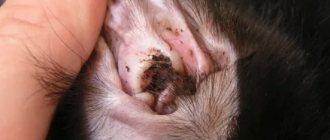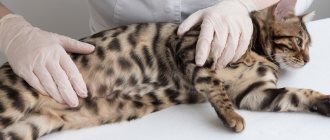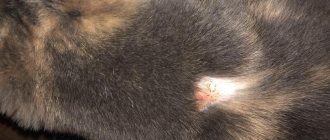Finding blackheads in the ears of cats and kittens is alarming, but it doesn't necessarily mean the animal has a terrible disease. These symptoms may mean your pet has parasites. Just in case, you need to separate the kitten from other pets until you understand what is happening. As with any disease, this problem is best handled under the guidance of a veterinarian, but armed with useful information, you can calmly understand the situation and determine a course of action.
Causes and diseases that cause black plaque to appear
Insects and parasites most commonly cause ear infections—resulting in red, swollen, itchy, or blistering—either as a result of direct damage from a parasite bite or as a result of increased sensitivity. It is because of parasites that black dots most often appear in a kitten’s ears.
Recognizing ticks and knowing how to treat them is important to your pet's well-being. The mites themselves sometimes become a big problem; however, the real danger is that the kitten scratches itself in an attempt to relieve the itching. This can lead to deep wounds.
Checking a cat's ears
Otodectosis or ear scabies
Scabies is caused by microscopic mites. There are several types of mites that cause it. One of the most common types of inflammation of the external auditory canal (otitis externa) in cats is otodegitosis caused by Otodectes cynotis mites. Mites infect the skin and ears, and signs of their appearance include black dirt in the cat’s ear, redness, partial hair loss, itching and general inflammation of the skin.
The ear mite Otodectes cynotis can be found in cats, dogs, rabbits and ferrets. It is most often found in the ear canal, although it can also live on the skin surface. They are very easy to become infected through direct contact with a sick animal. The tick is barely visible to the naked eye; sometimes you can see a white speck that moves against a dark background.
Adults live for about 2 months, during which time they reproduce continuously. Despite the fact that their entire life is spent on a host animal, they can survive in the environment for some time.
Formation of sulfur plugs
Although most cats do not develop ear wax, it does sometimes happen. If you see dark accumulations of wax that also stink, this indicates a painful condition, such as a yeast or fungal infection, ear mites, or other irritations in the ear. If your cat's ears look healthy, have pale pink skin and light brown earwax, this is normal.
Earwax itself is normal in a cat, but if you see that your cat has a dark coating in his ear and is also shaking his head and scratching his ears, he most likely has ear mites.
Cats' sulfur is brown. If there are no parasites in the ears, then she will not have a smell. A cat with ear mites has wax that is dark brown or black and looks like coffee grounds. It will also smell bad.
If there is too much wax, it can clog the ear canal and lead to inflammation. To prevent this from happening, you need to carefully clean your cat's ears every month. It is best to do this with a special lotion, which is sold at a veterinary pharmacy. If the condition is advanced, be sure to contact your veterinarian.
Scabies mite
Appearance of an ear mite
Mites can cause irritation where they attach and can be found on the pinna or in the ear canal. Ear mites are a fairly common parasite in pets. Ticks are microscopic and infectious organisms that appear as tiny white dots, barely visible to the naked eye. They can be detected under a microscope. Ear mites live on the skin of the ear canal and feed on earwax and sebum. They not only cause infection, but can also cause allergies in the animal.
To prescribe the correct treatment, consultation with a veterinarian is necessary. Sometimes the cause of blackheads in the ears can be a yeast or fungal infection, and delayed or incorrect treatment can worsen your pet's condition.
Symptoms of ear disease
A healthy individual has a pink auricle, its surface is dry, and there is no pungent odor.
The owner should be wary of the anxiety of his four-legged friend. The first signs of ear disease in cats:
- Tilts head to one side;
- Frequent scratching;
- The pet refuses to eat;
- Sharp shaking of the head;
- Swelling is noticeable.
Behavior can be aggressive when trying to look into the ear, or vice versa lethargic. Discharge of different colors or smells may appear, the color of the skin may change, peeling on the inside and dermatitis on the outside may occur.
When the base of the ear is pressed slightly, squelching sounds occur. Such phenomena should not be ignored. The photo shows ear diseases in cats, and we see how hard it is for our pets. In these cases, you need to contact the clinic, specialists will provide the necessary assistance.
Characteristic symptoms
One of the symptoms is itching in the ear
An animal can become infected in several ways: while walking, playing on the lawn, in the garden, etc.; from a mother cat infected with ear mites; from other animals; as a result of lack of ear hygiene.
Ear mite infestation is a very common problem in kittens, although animals of any age are susceptible to this disease. Signs of infection can have varying degrees of severity and appear comprehensively or partially. In addition to the fact that a cat has dark plaque in its ear, the following symptoms of the disease can be detected:
- Scratching and constant head shaking caused by irritation.
- Discharge of a waxy dark substance from the ears.
- Hair loss due to herbs caused by scratching.
- Presence of a rash in the ear.
- The presence of a hematoma in the ear (its appearance causes rupture of small blood vessels between the skin and cartilage as a result of scratches).
Skin lesions most often affect the ear and surrounding areas, but other parts of the body can sometimes be affected.
The essence of the problem
The most common place where cat acne appears is the chin. Dark dots are least likely to be seen on the tail. Fleas or other parasites leave their waste products anywhere on the animal's body. In advanced cases, the spots on the cat’s fur are localized in the following areas :
- folds on the paws;
- inner thighs;
- eyelids;
- nipples;
- jaws.
© shutterstock
Dark spots can also be found around the anus. If multiple black rashes appear on your pet's skin, you should see a veterinarian.
Possible complications
Ear cleaning is a must.
Itching can cause a lot of inconvenience for your pet, but, unfortunately, this is only the beginning of the problem. There are many more reasons why it is important to pay attention to this problem in time. Scratches can lead to infection. In extreme situations, these infections can lead to hearing loss and balance problems as a result of the ear canal being blocked.
If infected wounds are left untreated, your pet may continue to have hearing problems, so it is important to see a veterinarian as soon as possible if you notice a wound.
Mites cause irritation and inflammation; infection can spread to both the external and internal auditory canals. This can lead to more serious skin or ear infections. As a result of the accumulation of characteristic secretions, complete closure of the ear canal may occur, which will lead to partial or complete hearing loss. Advanced inflammatory processes worsen, penetrating deeper and deeper, causing suffering to the animal.
Diagnostic methods
Ear examination by a veterinarian
Diagnosis is most often carried out by examining the animal's ears using a special otoscope instrument. Sometimes animals do not like this procedure, then the veterinarian uses a cotton swab to carefully collect samples of discharge from the ears and conduct a microscopic examination.
You can try to determine the presence of ticks at home. To do this, you need to carefully remove the discharge from the ear and shake it onto a sheet of black paper. If you notice tiny white dots moving around, then your furry friend has mites.
Sometimes the parasites are deep in the ear canal, where you cannot see them. If you suspect your cat has mites, gently massage the back of the ear at the base with your thumb and forefinger. A cat without ticks will usually enjoy it or, in the worst case, fuss and try to escape. An animal that has parasites will usually begin to scratch and itch vigorously.
Treatment options
Ear Instillations
There are different ways to treat ear mites, and your veterinarian should choose a regimen that is appropriate for your pet. Medicines you can buy yourself may not be as effective or take longer to cure than medications prescribed by your veterinarian. Some modern drugs require one-time use and are effective.
Before carrying out treatment, it is necessary to thoroughly clean the ears of discharge, this reduces irritation and helps get rid of some mites.
To successfully treat ear mites, it is important to strictly adhere to your veterinarian's recommended dosage regimen (usually twice daily for a week or more). Your doctor may also prescribe medications to reduce inflammation and treat secondary bacterial or yeast infections.
All pets should be treated at the same time, even if they are asymptomatic.
Use of drugs
Preparations for the treatment of ticks
Sprays, ointments or drops are used for treatment. The choice of remedy depends on the degree of damage, the presence of infections, and the age of the pet. Therefore, it is important to consult a veterinarian to select a drug. Most often, Acaromectin spray, Surolan, Oricin, Bars, Otoferonol Gold, and aversctin ointment are used for treatment. Vprey is very easy to use. As a rule, the animal's ears are treated twice, 8-10 days should pass between applications. Aversktin ointment is also applied twice with an interval of 5-7 days. The scheme for using drops depends on the active substance. The veterinarian selects the most appropriate treatment regimen in each specific case, based on the condition of the animal.
Traditional methods
Home remedies can only be used if the infection is minor and the animal has a strong immune system.
Treating ear mites in a cat is a three-step process. The first step is to get as many parasites out of your ear canal as possible by cleaning your ear. You can use an ear cleaning solution (available at pet stores) or try almond or olive oil, but it's best to check with your veterinarian the first time. Place a few drops of the solution or oil into the ear canal and massage gently. Massaging will help draw dirt out to the outside of the ear, where it can be wiped away with a cotton swab or cloth. Do not use cotton swabs because they may slip off and puncture your eardrum. Repeat the cleaning procedure until your ear is clean.
Sulfur ointment is used to relieve itching and heal wounds. Using boric acid, the pet's ear canals are cleaned of dirt and inflammatory products. Camphor oil helps soften and remove crusts and scabs. Since sulfur ointment dries out the skin greatly, it is necessary to periodically moisten the treated areas with antiseptic solutions. After you have treated the auricle with boric acid, you can use antiparasitic drugs. To make the animal more comfortable during the procedures. It is recommended to heat these products to 35-37 C.
Home remedies are usually effective in the initial stages of infection, but there is always a chance that none of them will give the desired result. In this case, the kitten should be taken to the veterinarian immediately.
How can you tell if your cat has acne?
Cat acne can be confused with other similar diseases, however, there are several secrets that will allow you to avoid getting into trouble and correctly diagnose the disease. To understand what you are dealing with - black dots or grains, traces of fleas, you need to carry out a few simple steps.
Many inattentive pet owners often mistake various grains, insect feces, or dirt caught in the fur for acne. However, the grains are usually very easy to blow away. The same cannot be said about cat acne. You can’t just “blow away” this disease.
Another indicator is the localization of the disease. If fleas leave marks all over the animal's body, then cat acne is often located in a specific place. We'll tell you where exactly a little later.
Fortunately for our four-legged friends, acne is not such a frequent guest in animals. “Cat acne” can be located on a wide variety of areas of the pet’s body. Some owners suddenly notice black spots on the stomach or chin, others find the problem on the tail or at the base of the ears. It is possible that, in addition to the chin, they can also appear in the corners of the mouth or the area between the eyebrows.
Why there? It's simple, because in these places, especially on the chin, the largest number of sebaceous glands is concentrated, the improper functioning of which provokes the development of all kinds of diseases. Illnesses often begin with what appears to be a harmless, at first glance, clogged pore.
Pets' susceptibility to disease
Different pets experience acne differently. Some cats are characterized by constantly recurring cases of blackheads, while others cannot get rid of acne at all. As for the frequency and severity of the disease, this indicator depends on the characteristics of a particular individual.
It is very important to understand that no cat is immune from developing acne. This “trouble” can affect any pet, regardless of its breed, age or gender. So you need to very carefully monitor the condition of your pet’s skin and promptly seek the correct treatment.
Prevention of ear diseases in animals
Treatment of a kitten at the veterinarian
Preventing the onset of disease is much easier than treating an infected animal. To keep your pet safe, have your pet's ears cleaned and checked by a veterinarian monthly. It is also recommended to deworm your kitten regularly. The likelihood of ear mite infestation increases if your kitten comes into contact with other animals that may be carriers. Therefore, try to avoid unwanted contacts. Also make it a habit to clean your home and pets' bedding twice a week to reduce the risk of infection.
Video “How to properly wash a cat’s ears”
In this video you can see how to properly clean your pet's ears so as not to cause acne.
Sorry, there are no surveys available at this time.
Was this article helpful?
Thank you for your opinion!
The article was useful. Please share the information with your friends.
Yes
No
X
Please write what is wrong and leave recommendations on the article
Cancel reply
Rate the benefit of the article: Rate the author ( 2 votes, average: 5.00 out of 5)
Discuss the article:











